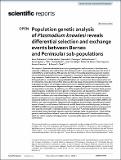Files in this item
Population genetic analysis of Plasmodium knowlesi reveals differential selection and exchange events between Borneo and Peninsular sub-populations
Item metadata
| dc.contributor.author | Turkiewicz, Anna | |
| dc.contributor.author | Manko, Emilia | |
| dc.contributor.author | Oresegun, Damiola R. | |
| dc.contributor.author | Nolder, Debbie | |
| dc.contributor.author | Spadar, Anton | |
| dc.contributor.author | Sutherland, Colin J. | |
| dc.contributor.author | Cox-Singh, Janet | |
| dc.contributor.author | Moon, Robert W. | |
| dc.contributor.author | Lau, Yee-Ling | |
| dc.contributor.author | Campino, Susana | |
| dc.contributor.author | Clark, Taane G. | |
| dc.date.accessioned | 2023-02-13T12:30:13Z | |
| dc.date.available | 2023-02-13T12:30:13Z | |
| dc.date.issued | 2023-02-07 | |
| dc.identifier | 283353881 | |
| dc.identifier | af0072d1-f653-4abb-af85-68837f9cf8a2 | |
| dc.identifier | 85147573093 | |
| dc.identifier.citation | Turkiewicz , A , Manko , E , Oresegun , D R , Nolder , D , Spadar , A , Sutherland , C J , Cox-Singh , J , Moon , R W , Lau , Y-L , Campino , S & Clark , T G 2023 , ' Population genetic analysis of Plasmodium knowlesi reveals differential selection and exchange events between Borneo and Peninsular sub-populations ' , Scientific Reports , vol. 13 , no. 1 , 2142 . https://doi.org/10.1038/s41598-023-29368-4 | en |
| dc.identifier.issn | 2045-2322 | |
| dc.identifier.other | Jisc: 888612 | |
| dc.identifier.other | publisher-id: s41598-023-29368-4 | |
| dc.identifier.other | manuscript: 29368 | |
| dc.identifier.other | ORCID: /0000-0003-4878-5188/work/129147747 | |
| dc.identifier.uri | https://hdl.handle.net/10023/26963 | |
| dc.description | Funding: A.T. was funded by a Newton Institutional Links Grant (British Council, no. 261868591). S.C. was funded by BloomsburySET and Medical Research Council UK grants (MR/M01360X/1, MR/R025576/1, MR/R020973/1, and MR/X005895/1). T.G.C. was funded by the Medical Research Council UK (Grant nos. MR/M01360X/1, MR/N010469/1, MR/R025576/1, MR/R020973/1, and MR/X005895/1). | en |
| dc.description.abstract | The zoonotic Plasmodium knowlesi parasite is a growing public health concern in Southeast Asia, especially in Malaysia, where elimination of P. falciparum and P. vivax malaria has been the focus of control efforts. Understanding of the genetic diversity of P. knowlesi parasites can provide insights into its evolution, population structure, diagnostics, transmission dynamics, and the emergence of drug resistance. Previous work has revealed that P. knowlesi fall into three main sub-populations distinguished by a combination of geographical location and macaque host (Macaca fascicularis and M. nemestrina). It has been shown that Malaysian Borneo groups display profound heterogeneity with long regions of high or low divergence resulting in mosaic patterns between sub-populations, with some evidence of chromosomal-segment exchanges. However, the genetic structure of non-Borneo sub-populations is less clear. By gathering one of the largest collections of P. knowlesi whole-genome sequencing data, we studied structural genomic changes across sub-populations, with the analysis revealing differences in Borneo clusters linked to mosquito-related stages of the parasite cycle, in contrast to differences in host-related stages for the Peninsular group. Our work identifies new genetic exchange events, including introgressions between Malaysian Peninsular and M. nemestrina-associated clusters on various chromosomes, including in parasite invasion genes (DBPβ, NBPXα and NBPXβ), and important proteins expressed in the vertebrate parasite stages. Recombination events appear to have occurred between the Peninsular and M. fascicularis-associated groups, including in the DBPβ and DBPγ invasion associated genes. Overall, our work finds that genetic exchange events have occurred among the recognised contemporary groups of P. knowlesi parasites during their evolutionary history, leading to apparent mosaicism between these sub-populations. These findings generate new hypotheses relevant to parasite evolutionary biology and P. knowlesi epidemiology, which can inform malaria control approaches to containing the impact of zoonotic malaria on human communities. | |
| dc.format.extent | 13 | |
| dc.format.extent | 3515197 | |
| dc.language.iso | eng | |
| dc.relation.ispartof | Scientific Reports | en |
| dc.subject | QH426 Genetics | en |
| dc.subject | QR Microbiology | en |
| dc.subject | DAS | en |
| dc.subject | SDG 3 - Good Health and Well-being | en |
| dc.subject | MCC | en |
| dc.subject.lcc | QH426 | en |
| dc.subject.lcc | QR | en |
| dc.title | Population genetic analysis of Plasmodium knowlesi reveals differential selection and exchange events between Borneo and Peninsular sub-populations | en |
| dc.type | Journal article | en |
| dc.contributor.institution | University of St Andrews. School of Medicine | en |
| dc.contributor.institution | University of St Andrews. Centre for Research into Equality, Diversity & Inclusion | en |
| dc.contributor.institution | University of St Andrews. Biomedical Sciences Research Complex | en |
| dc.contributor.institution | University of St Andrews. St Andrews Bioinformatics Unit | en |
| dc.contributor.institution | University of St Andrews. Infection and Global Health Division | en |
| dc.identifier.doi | 10.1038/s41598-023-29368-4 | |
| dc.description.status | Peer reviewed | en |
This item appears in the following Collection(s)
Items in the St Andrews Research Repository are protected by copyright, with all rights reserved, unless otherwise indicated.

